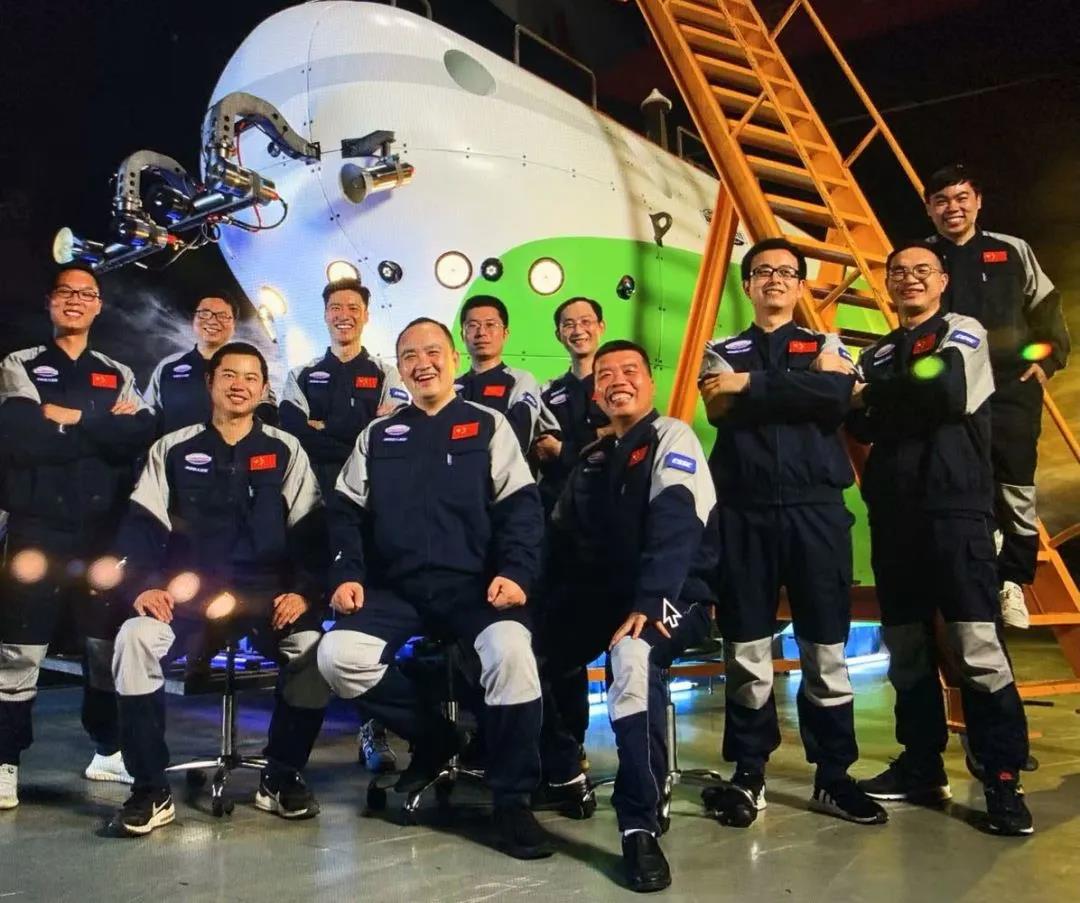Submersible's developers discuss 'incredible' mission

Engineers pose for a photo in Sanya, South China's Hainan province, in September before their expedition to the Mariana Trench. [Photo provided to chinadaily.com.cn]
Coming off a recent expedition to the world's deepest location, the developers of China's new deep-sea manned submersible shared their feelings about the monumental underwater experience.
"It's incredible," said Zhang Wei, one of three pilots of the submersible Fendouzhe (Striver), describing his maiden trip to the Pacific Ocean's Mariana Trench, the deepest natural frontier on Earth.
The vehicle completed 13 dives in October and November, eight of which exceeded a depth of 10,000 meters, including a national-record depth of 10,909 meters on Nov 10.
"The seafloor, where we landed, is actually very flat. There is such a thick layer of sediment that objects sink easily. I've also seen some marine life, such as sea cucumbers and a kind of gammarid species," Zhang said.
For veterans, however, reaching 10,000 meters was simply a difference of numbers.
"It means we have a five-digit number instead of four-digit," answered Ye Cong, 41, Fendouzhe's chief designer.
"It was not my first time aboard a deep-sea manned sub, after all. I was more relaxed than 10 years ago. My focus was more on the improvements of the vehicles' general performance," Zhang said.
He added that the 36-ton vehicle impressed him because it is more reliable and comfortable than other submersibles.
Fendouzhe was developed by the China Ship Scientific Research Center based in Wuxi, a modern manufacturing hub in Jiangsu province.
The 800-million-yuan ($122 million) project was launched in 2016 as a vital part of the country's deep-sea technology and equipment blueprint plan for the 13th Five-Year Plan period (2016-20).
As China's largest ship and ocean engineering research institute, the center is behind the success of all the country's three deep-sea manned submersibles-Jiaolong (Sea Dragon), Shenhai Yongshi (Deep Sea Warrior) and Fendouzhe.
Fendouzhe has shown significant improvements over its predecessors in almost every facet, including descending and ascending speeds, material toughness and battery capacity.
The institute put nearly 100 researchers and elite engineers on the Fendouzhe project. The team was responsible for the vehicle's coordinated manufacturing, which entails several stages of design, debugging and integration of hardware and software, according to Hu Zhen, the submersible's deputy chief designer.
"Our team members come together from all kinds of backgrounds to meet the comprehensive design and assembling requirements of Fendouzhe," Hu said. "But that's still not enough. More than 100 scientific institutions from across the country have our back, providing their technologies and inventions."
Creating the submersible's spherical cabin alone was a joint effort involving dozens of research institutes and companies, said Li Yanqing, another deputy chief designer of Fendouzhe.
The cabin uses a new titanium alloy that is lightweight and has the strength to withstand the immensely high pressure in the abyss. The material was created by the Institute of Metal Research of the Chinese Academy of Sciences, which also developed a new welding and manufacturing technique to make the giant titanium sphere.
The cabin, after being welded, underwent complicated flaw and residual stress detection by professional testing organizations in Wuxi, he added.
Even after the submersible rolled off the line, the job for the engineers was far from over, as they had to perform meticulous checkups and maintenance before each of the vehicle's tests in the water.
Du Kun, a senior technician responsible for the cabin's sealing operation, revealed that during the cabin work, he didn't wear a helmet, watches or rings-anything that could cause a scratch on the delicately sealed windows and gate by chance, however tiny it was.
Barring such items during the project was protocol for the special working environment, Du said.
"All three pilots' lives were in the hands of Mr Du. You can say that," pilot Zhang explained. "Any human error, such as missed impurities or unconfirmed seals, could put us at life-threatening risk."
Fendouzhe is now docked at the southern Chinese port city of Sanya, Hainan province, for post-expedition checkups before being officially put into use for ocean exploration purposes.
But for its engineers, the mission doesn't stop here.
"We've been to the bottom of the ocean, indeed. But the depth is just one of the goals for us," Ye said. "There are multiple complicated scenes in the ocean, meaning we have to develop more submersibles, adapting to those environments for future exploration. And I'm fairly confident that we can do that-raise our deep-sea technologies to the next level."










